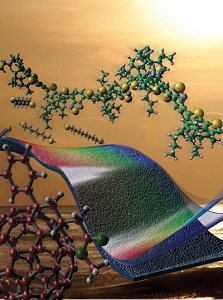New organic solar technology reaches 6.7 percent efficiency within a year
 New research into small-molecule based organic photovoltaics at the University of California Santa Barbara has yielded cells that are 6.7 percent efficient at converting light to energy.
New research into small-molecule based organic photovoltaics at the University of California Santa Barbara has yielded cells that are 6.7 percent efficient at converting light to energy.
It’s a far cry from the efficiency of crystalline silicon PV—SunPower’s Maxeon solar cells are rated at 22.4 percent efficiency, for instance. But it’s no small feat, considering that the research started a year ago.
The research was conducted by university professors Alan Heeger, a Nobel chemistry prize winner, and Guillermo Bazan. They developed a small molecule that can be deposited in solution at room temperatures
“The importance of depositing by solution is it’s cheaper,” Bazan said.
In solution, the photovoltaic material can be printed by a number of applications, like roll-to-roll printing, similar to printing a newspaper or book, using standard types of film deposition, according to Bazan.
Most organic PV is made with polymers, according to MIT’s Technology Review. That’s because the polymers form long strands tangle into a stable film. Small molecules were harder to get similar results from because they create a stable, planar film. Small molecules could be deposited via vapor deposition, which is more expensive, Bazan said.
“I think there’s been great suspicion that it’s possible to get small molecules from solution,” he said. But this is the first time they’ve done it at this efficiency level.
In the device, the molecule is coupled with a fullerene. The molecule transfers the charge to the fullerene creating electricity.
The molecule was made through tinkering with the solution.
“That’s good old-fashioned standard organic chemistry,” Bazan said. But nanoscale distribution of those phases of the thin-film need to be precisely orchestrated.
“That’s why it is a tricky proposition, obtaining the correct nano-morphology.”
In all, it took Bazan and Heeger a little under a year to develop the molecule, from synthesis to verifying and reproducing the molecule and testing it. Going forward they hope to reach efficiency levels of roughly 9 percent.
“Now it should be much easier; there were some bottlenecks,” Bazan said.
Image courtesy of UC Santa Barbara.



